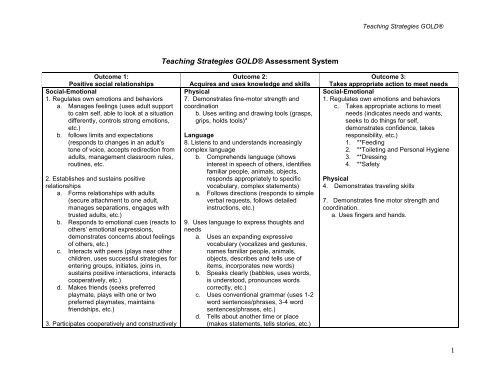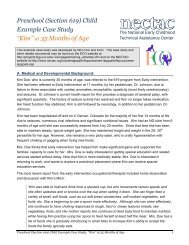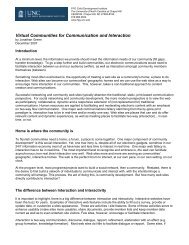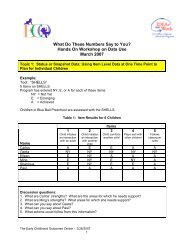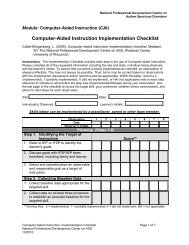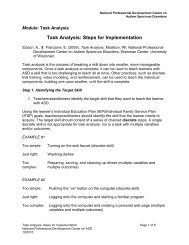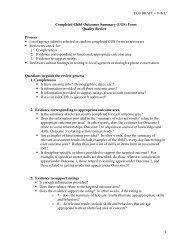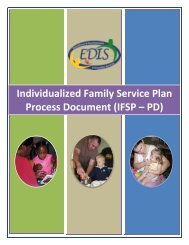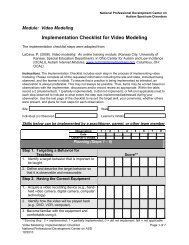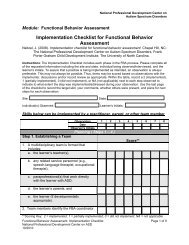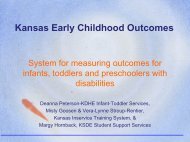Teaching Strategies Gold
Teaching Strategies Gold
Teaching Strategies Gold
Create successful ePaper yourself
Turn your PDF publications into a flip-book with our unique Google optimized e-Paper software.
<strong>Teaching</strong> <strong>Strategies</strong> GOLD®<br />
<strong>Teaching</strong> <strong>Strategies</strong> GOLD® Assessment System<br />
Outcome 1:<br />
Positive social relationships<br />
Social-Emotional<br />
1. Regulates own emotions and behaviors<br />
a. Manages feelings (uses adult support<br />
to calm self, able to look at a situation<br />
differently, controls strong emotions,<br />
etc.)<br />
b. follows limits and expectations<br />
(responds to changes in an adult’s<br />
tone of voice, accepts redirection from<br />
adults, management classroom rules,<br />
routines, etc.<br />
2. Establishes and sustains positive<br />
relationships<br />
a. Forms relationships with adults<br />
(secure attachment to one adult,<br />
manages separations, engages with<br />
trusted adults, etc.)<br />
b. Responds to emotional cues (reacts to<br />
others’ emotional expressions,<br />
demonstrates concerns about feelings<br />
of others, etc.)<br />
c. Interacts with peers (plays near other<br />
children, uses successful strategies for<br />
entering groups, initiates, joins in,<br />
sustains positive interactions, interacts<br />
cooperatively, etc.)<br />
d. Makes friends (seeks preferred<br />
playmate, plays with one or two<br />
preferred playmates, maintains<br />
friendships, etc.)<br />
3. Participates cooperatively and constructively<br />
Outcome 2:<br />
Acquires and uses knowledge and skills<br />
Physical<br />
7. Demonstrates fine-motor strength and<br />
coordination<br />
b. Uses writing and drawing tools (grasps,<br />
grips, holds tools)*<br />
Language<br />
8. Listens to and understands increasingly<br />
complex language<br />
b. Comprehends language (shows<br />
interest in speech of others, identifies<br />
familiar people, animals, objects,<br />
responds appropriately to specific<br />
vocabulary, complex statements)<br />
a. Follows directions (responds to simple<br />
verbal requests, follows detailed<br />
instructions, etc.)<br />
9. Uses language to express thoughts and<br />
needs<br />
a. Uses an expanding expressive<br />
vocabulary (vocalizes and gestures,<br />
names familiar people, animals,<br />
objects, describes and tells use of<br />
items, incorporates new words)<br />
b. Speaks clearly (babbles, uses words,<br />
is understood, pronounces words<br />
correctly, etc.)<br />
c. Uses conventional grammar (uses 1-2<br />
word sentences/phrases, 3-4 word<br />
sentences/phrases, etc.)<br />
d. Tells about another time or place<br />
(makes statements, tells stories, etc.)<br />
Outcome 3:<br />
Takes appropriate action to meet needs<br />
Social-Emotional<br />
1. Regulates own emotions and behaviors<br />
c. Takes appropriate actions to meet<br />
needs (indicates needs and wants,<br />
seeks to do things for self,<br />
demonstrates confidence, takes<br />
responsibility, etc.)<br />
1. **Feeding<br />
2. **Toileting and Personal Hygiene<br />
3. **Dressing<br />
4. **Safety<br />
Physical<br />
4. Demonstrates traveling skills<br />
7. Demonstrates fine motor strength and<br />
coordination.<br />
a. Uses fingers and hands.<br />
1
<strong>Teaching</strong> <strong>Strategies</strong> GOLD®<br />
in group situations<br />
a. Balances needs and rights of self and<br />
others (responds appropriately to<br />
others’ wants, takes turns, initiates<br />
sharing, cooperates and shares ideas,<br />
etc.)<br />
b. Solves social problems (expresses<br />
feelings during conflict, seeks adult<br />
help, suggests solutions, resolves<br />
problems, etc.)<br />
Language<br />
8. Listens to and understands increasingly<br />
complex language<br />
a. Comprehends language (shows<br />
interest in speech of others, identifies<br />
familiar people, animals, objects,<br />
responds appropriately to specific<br />
vocabulary, complex statements)<br />
10. Uses appropriate conversational and other<br />
communication skills<br />
a. Engages in conversations (simple<br />
back-and-forth, initiates, engages in<br />
conversation, etc.)<br />
b. Uses social rules of language (looks at<br />
listener, etc.)<br />
Cognitive<br />
11. Demonstrates positive approaches to<br />
learning<br />
a. Attends and engages (pays attention<br />
to sights and sounds, sustains interest,<br />
sustains work on tasks, etc.)<br />
b. Persists (repeats actions to obtain<br />
results, practices an activity, plans and<br />
pursues tasks, etc.)<br />
c. Solves problems (reacts to problem,<br />
observes and imitates problem<br />
solving, etc.)<br />
d. Shows curiosity and motivation (uses<br />
senses, explores and investigates,<br />
shows eagerness to learn, uses a<br />
variety of resources to answer<br />
questions, etc.)<br />
e. Shows flexibility and inventiveness in<br />
thinking (imitates others using objects,<br />
uses creativity and imagination in play,<br />
changes plans if a better idea is<br />
thought of, thinks through solutions,<br />
etc.)<br />
12. Remembers and connects experiences<br />
a. Recognizes and recalls (recognizes<br />
familiar people, places objects, looks<br />
for hidden objects, tells about<br />
experiences in order, uses strategies<br />
to remember, etc.)<br />
b. Makes connections (looks for familiar<br />
persons when tames, remembers<br />
sequence of personal routines, draws<br />
on everyday experiences, applies<br />
rules to new contexts, etc.)<br />
13. Uses classification skills (matches similar<br />
2
<strong>Teaching</strong> <strong>Strategies</strong> GOLD®<br />
objects, places objects in 2 or more groups,<br />
groups objects by characteristics, etc.)<br />
14. Uses symbols and images to represent<br />
something not present<br />
a. Thinks symbolically (recognizes<br />
people, objects animals in pictures,<br />
draws and identifies what it is, uses<br />
drawings, etc., to represent ideas, etc.)<br />
b. Engages in sociodramatic play<br />
(imitates actions during play, acts out<br />
scenarios, interacts with children in<br />
pretend play, etc.)<br />
Literacy<br />
15. Demonstrates phonological awareness<br />
a. Notices and discriminates rhyme (joins<br />
in rhyming songs and games, fills in<br />
missing rhyming word, generates<br />
rhyming words, etc.)<br />
b. Notices and discriminates alliteration<br />
(sings songs with repeating initial<br />
sounds, aware some words begin the<br />
same way, matches beginning sounds,<br />
isolates and identifies beginning<br />
sounds, etc.)<br />
c. Notices and discriminates smaller and<br />
smaller units of sound (hears, shows<br />
awareness of separate words in<br />
sentences, separate syllables, verbally<br />
separates and blends phonemes, etc.)<br />
16. Demonstrates knowledge of the alphabet<br />
a. Identifies and names letters<br />
(recognizes and names letters in own<br />
name, other letters, upper and lower<br />
case, etc.)<br />
3
<strong>Teaching</strong> <strong>Strategies</strong> GOLD®<br />
b. Uses letter-sound knowledge<br />
(identifies sounds of letters, produces<br />
correct sounds, understands sequence<br />
of letters, applies letter-sound<br />
correspondence, etc.)<br />
17. Demonstrates knowledge of print and its<br />
uses<br />
a. Uses and appreciates books (shows<br />
interest in books, orients book, knows<br />
features of a book, uses various types<br />
of books, etc.)<br />
b. Uses print concepts (understands text<br />
is meaningful, can be read, indicates<br />
where to start reading, aware of<br />
features of print, matches written and<br />
spoken word, etc.)<br />
18. Comprehends and responds to books and<br />
other texts<br />
a. Interacts during read-alouds and book<br />
conversations (contributes language<br />
from book at appropriate time, asks<br />
and answers questions about text,<br />
identifies story-related problems,<br />
reconstructs story, etc.)<br />
b. Uses emergent reading skills<br />
(pretends to read, tries to match oral<br />
language and words on page, etc.)<br />
c. Retells stories (retells events, familiar<br />
stories, with detail, etc.)<br />
19. Demonstrates emergent writing skills<br />
a. Writes name (scribbles or marks,<br />
partially accurate, accurate, etc.)<br />
b. Writes to convey meaning (scribbles or<br />
marks, mock letters letter strings,<br />
4
<strong>Teaching</strong> <strong>Strategies</strong> GOLD®<br />
invented spelling, etc.)<br />
Mathematics<br />
20. Uses number concepts and operations<br />
a. Counts (verbally counts, uses number<br />
names, etc.)<br />
b. Quantifies (demonstrates<br />
understanding of concepts of 1, 2,<br />
more, recognizes names of numbers,<br />
makes sets, solves problems, etc.)<br />
c. Connects numerals with their<br />
quantities (recognizes, names<br />
numerals, identifies numerals, etc.)<br />
21. Explores and describes spatial<br />
relationships and shapes<br />
a. Understands spatial relationships<br />
(follows simple directions related to<br />
position, proximity, uses and responds<br />
to positional words, uses sketches to<br />
locate objects, etc. )<br />
b. Understands shapes (matches,<br />
identifies, describes shapes, etc.)<br />
22. Compares and measures (compares<br />
objects, orders set of objects uses<br />
measurement words, etc.)<br />
23. Demonstrates knowledge of patterns<br />
(shows interest in patterns, copies, creates,<br />
recognizes patterns, etc.0<br />
Science and Technology<br />
24. Uses scientific inquiry skills<br />
25. Demonstrates knowledge of the<br />
characteristics of living things<br />
26. Demonstrates knowledge of the physical<br />
5
<strong>Teaching</strong> <strong>Strategies</strong> GOLD®<br />
properties of objects and materials<br />
27. Demonstrates knowledge of Earth’s<br />
environment<br />
28. Uses tools and other technology to<br />
perform tasks<br />
Social Studies<br />
29. Demonstrates knowledge about self<br />
30. Shows basic understanding of people and<br />
how they live<br />
31. Explores change related to familiar people<br />
or places<br />
32. Demonstrates simple geographic<br />
knowledge<br />
English Language Acquisition<br />
37. Demonstrates progress in listening to and<br />
understanding English (observes others as<br />
they converse in English, responds to and<br />
understands English words and phrases, etc.)<br />
38. Demonstrates progress in speaking<br />
English (repeats sounds and words in English,<br />
uses socially interactive terms, develops<br />
multiword phrases, uses grammar, etc.)<br />
*Precursor skills for functional behaviors. These skills may not be appropriate or expected for some children, including those with sensory, motor, or other<br />
impairments.<br />
6


